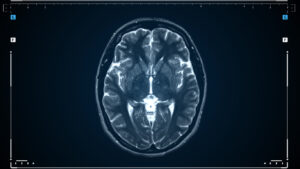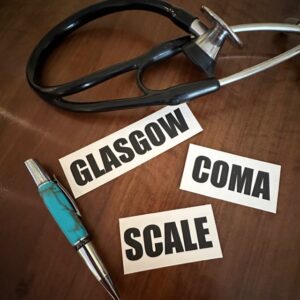In all honesty, at times the writing about coma (disorders of consciousness) in television and movies can be laughable. A character on a soap opera awakens dramatically after years in a deep coma and talks perfectly with no confusion.
Right.
Robin Cook’s second novel Coma is considered the genesis of a new suspense genre called medical thrillers. I might argue that the first medical thriller was Andromeda Strain by another physician-writer, Michael Crichton, which involved a group of doctors trying to discover anything to destroy an alien germ species fast killing off humans. Interestingly, Crichton later directed the movie Coma.
The designations of light, medium, and deep coma are outdated even if still used as a descriptor.
Coma is defined as a full loss of consciousness and/or a Glasgow Coma Scale of 8 or less. Coma is not the same as sleep. If someone drops a bucket of ice on you while you’re asleep (unaided by medications, illegal drugs, or alcohol), you’ll respond.
A person in a coma won’t react to that stimulus and they won’t wake up and curse you, either.
What Causes Coma?
Many things can lead to coma:
> Traumatic head injuries
> Diabetic ketoacidosis (where blood sugars go very high) or diabetic hypoglycemia (blood sugar too low)
> Stroke – either a hemorrhage or a blood clot (called ischemic)
> Drug overdoses or poisonings, which includes narcotics, alcohol, carbon monoxide
> Drowning, cardiac arrest, shock, sepsis, severe hypothermia, or anything that leads to lack of oxygen going to the brain
> Seizures or status epilepticus. Status epilepticus is when seizures happen continuously, or nearly continuously. It can be fatal.
> Infections such as meningitis or encephalitis
Think of coma as the brain hitting the pause button.
Like the dreaded whirling icon that says your computer no longer responds to input. The computer (your brain) is on and sort of working but doesn’t respond to the cursor (your body).
The Glasgow Coma Scale
Coma in adults is tracked using the Glasgow Coma Scale, developed in 1974 by two British neurosurgeons at the University of Glasgow. One of the two, Dr. Bryan Jennett, helped coin the term vegetative state—which led to the unfortunate term “vegetables.” Drs. Jennett and Teasdale took three objective components of consciousness—eyes, verbal, and motor (muscle movement, not your car). The scale was intended to provide doctors with a standardized assessment of coma and predict how a patient might do.
Remember, when writing about a coma: After four months in a coma, eighty-five percent of patients will NOT recover. Click To Tweet
Glasgow Coma Scale testing is the same for all over age fourteen. A score of fifteen is normal. A score less than three indicates severe, deep cessation of brain function and likely predicted brain death. Problems with the GCS are in patients who can’t speak, either due to young age or another condition such as a stroke, that impairs speech and/or movement. In general, the score is pretty accurate at determining how severe the brain injury or insult has been and the outcome.
Problems crop up though for example in children. Babies and toddlers can’t yet talk for the verbal assessment. Another difficulty would be in people with strokes or other inability to move. In general, though, the score is pretty accurate at determining the severity of a brain injury and the eventual prognosis.
The GCS isn’t used for children under age fourteen.
A more recent modified scale is used, the pediatric GCS (pGCS). For more specifics, www.rainbowrehab.com has a great article, “Understanding the Pediatric Glasgow Coma Scale.” UpToDate has a nice side-by-side comparison chart of the GCS and pGCS—google “pediatric coma scale.”
During my internship, a three-year-old girl drowned and was rescued by a HEROIC cop who dove into a dirty, leaf-filled, half-empty swimming pool, found her in all the muck, and resuscitated her. When she arrived at the ER and I intubated her, her GCS was quite low. (The pGCS hadn’t been developed yet). Our PICU staff doctors feared she had suffered severe hypoxic brain damage due to the length of time she was in the pool.
It was a cold-weather drowning, though, which changed her prognosis.
That same night I was on call, and while suctioning the child’s breathing tube one of the PICU nurses shouted for me. “Dr. Wells, her eyes are open!”
I ran over, and the little girl stared right up at me. She correctly shook her head to simple questions. She came off the ventilator within a couple of days and after a few days, went home. Years later, I spotted her wedding announcement in the newspaper.
That’s the best part of medicine.

The confusing part of writing about coma!
Two states of consciousness are often called coma but aren’t. True coma means you are unresponsive.
Frequently, patients recover to a low level of consciousness called Minimally Conscious State.
- MCS is diagnosed only after a minimum of one month.
- These patients respond to verbal commands or obnoxious things like my ice example above.
- They may say simple words.
- Their eyes may move if someone speaks to them. After a year in MCS, recovery is slim.
- Outcomes are better for MCS after a traumatic brain injury.
Persistent Vegetative State is the one talked about most in the media and the courts. These patients are not conscious but can move (without purpose), respond to pain, open their eyes, and even have a sleep/wake cycle.
- PVS is defined as such after it has lasted for at least one month.
- Chronic PVS is defined as PVS lasting more than a year after a traumatic brain injury OR three months after a non-traumatic brain injury.
- PVS patients are capable of spontaneous breathing.
- No reports exist of anyone in PVS recovering after three years, and most expire from infection.
- Children in PVS for three or more months may recover but do not regain functional skills.
And if that wasn’t confusing enough,
PVS and MCS can overlap.
Patients may fluctuate from one coma state to the other.
Rip Van Winkle exceptions:
-
Someone in a deep coma for weeks, months or years does not awaken to full alertness, although there are rare Rip Van Winkle exceptions. In 1996, Gary Dockery, a Tennessee policeman had been in a seven-year coma—not a persistent vegetative state. At times he moved his eyes in response to questions, so he was in a minimally conscious state. After a high fever, Gary abruptly came out his come to full awareness. He recognized and talked with his wife and two sons, even though both were now teenagers.
Dockery remained awake for eighteen hours, gradually sank back into a coma, and unfortunately died a year later.
The more common outcome for persistent vegetative state is like that of French soccer star John-Pierre Adams, who spent thirty-nine years in a coma after an anesthetic error during knee surgery. He finally passed away on September 6, 2021.
Patients who receive good nursing care can survive decades in a PVS.
Caveat when writing about coma:
Locked-in syndrome is NOT a form of coma. Locked-in syndrome is full body paralysis due to a neurological disorder. The brain is functional and awake, however only the patient’s eyes can move vertically and blink or in the worst cases, not at all.
Right now, there is no treatment for coma, PVS, and MCS other than supportive care.
Brain death occurs in a comatose person whose brain activity has ceased. Standard testing protocols exist for that but vary from country to country and even state to state. Click To Tweet

Brain MRI scan. Scanning of brain’s magnetic resonance image. Diagnostic Medical Tool
What Fiction Writers Need to Know About Coma Click To Tweet
- Please, don’t use coma from weeks to years as a cliché device to keep your character out of touch then have a sudden awakening to full consciousness and/or function. As a rule of thumb, the longer the coma, the longer it takes to recover. Recovery follows a gradient from less aware and less function to more fully aware and able to move.
- Most patients in a full coma lasting over one month will not return to fully normal functioning.
- Brief loss of consciousness, 1-3 days up to a week after a significant blow to the head, can work. The briefer the coma, the faster recovery, usually. They may still have other symptoms depending on what caused the coma and show signs/symptoms of traumatic brain injury.
- As always, kids recover quicker than adults. Elderly adults recover the slowest.
- The lower the GCS or pGCS, the worse your character’s likely outcome, although exceptions apply, as in my case above.
- Drowning in cold water changes prognosis for the better, especially in children.
- Coma length is highly unpredictable.
- Patients with traumatic injuries have better outcomes than those with non-traumatic reasons for their coma.
- Patients don’t recover as often with overdose, poisoning, prolonged hypoxia due to drowning or cardiac arrest, e.g., brain infection (encephalitis), or metabolic problems such as diabetic coma and other issues.
- Chronic PVS (persistent vegetative state) has the worst outcomes. In general, these patients don’t recover although rare exceptions exist.
- Walking and talking are highly complex neurological tasks. They are the final step in a full recovery that can take months to years. Not all coma survivors get these skills back.
- We writers love synonyms, but when using the following words to write about a character with coma, remember they also have a clinical definition as well. Look at who is using the terms – are they a layperson or a medical person?
Lethargy: hard to stay awake (medical term is aroused but in fiction that could be confusing depending on your genre)
Obtunded: Responds to stimuli other than pain
Stupor: Responds only to pain
Coma: unresponsive to pain
Avoid stilted medical dialogue Click To Tweet
Doctors and nurses would not say, “His Glasgow Coma Scale is eight.” They would just say, in the right context, “His Glasgow is eight.”
Deeper Dive:
Check out the free bookshelf at www.ncbi.nlm.nih.gov. Search for “Level of Consciousness” by Suzie C. Tindall (chapter 57 of a book.)
A fabulous resource including videos, charts and explanations can be found at www.glasgowcomascale.org. The site is user-friendly even for non-clinical writers. The prognostic charts can be used with the age of your adult patient and coma level to predict the risk of death and favorable outcome. Adjust your story as needed to get a more probable result.
|
Modified Glasgow Coma Scale for Writers © by Ronda Wells M.D. |
Points | |
| EYES | Opens Spontaneously | 4 |
| Opens to someone asking them to | 3 | |
| Opens to induced pain (pressure on tip of a fingernail e.g.) | 2 | |
| No response | 1 | |
| VERBAL | Can say who they are, where they are, and what day and/or time of day | 5 |
| Confused | 4 | |
| Uses wrong words but can speak words or short phrases | 3 | |
| Incomprehensible sounds | 2 | |
| No response | 1 | |
| MOVEMENT
(motor) |
Obeys commands to move | 6 |
| Tries to move away from an obnoxious pressure (Spock pinch) | 5 | |
| Flexes to pain (tries to bat the examiner away) | 4 | |
| Abnormal limb flexion (decorticate) | 3 | |
| Abnormal limb extension (decerebrate) | 2 | |
| No response | 1 | |
| TOTAL SCORE | ||
| Best Response | 15 | |
| Comatose | 8 or less | |
| Totally unresponsive | 3 |


